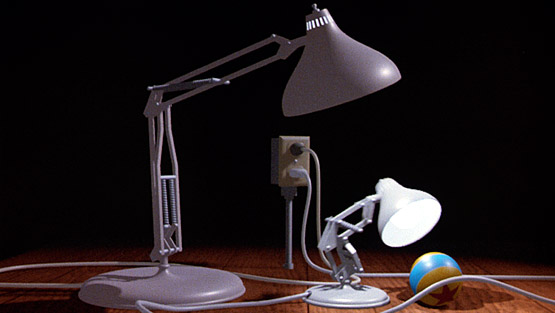

The Digital Turn: Animation in the Age of Information Technologies
Crawford's
essay aims at giving us the basics of digital animation as it might be practiced
at places like Pixar. For some people this should be very familiar territory;
for others, it provides the essential terminology and methodology. The central
question here is: How has the development of new digital technologies for image
production and manipulation affected everything from the creation of animated
texts, to their distribution, reception, and aesthetic characteristics? Beyond
that, there are some secondary questions. How far back to we have to go to trace
the beginnings of digital animation? What was digital animation first used for
in the US? What's "Blendo" and why was it such a breakthrough?  What
makes CGI such an improvement over technologies like Blendo? What do we mean
by "modeling" and "texture-mapping," and what do they allow
digital animators to do that was either impossible or prohibitively difficult
in analogue animation? In the early years of CGI, what about the rendering process
put the technology out of reach for most independent studios and animators?
Has that changed? How do digital animators define "realism"? What
makes mechanical objects relatively easier to animate than animal motion? How
have animators tried to solve this problem? What impact has this problem had
on the animation produced so far? What are "motion capture" and "inverse
kinesthetics" in this context?
What
makes CGI such an improvement over technologies like Blendo? What do we mean
by "modeling" and "texture-mapping," and what do they allow
digital animators to do that was either impossible or prohibitively difficult
in analogue animation? In the early years of CGI, what about the rendering process
put the technology out of reach for most independent studios and animators?
Has that changed? How do digital animators define "realism"? What
makes mechanical objects relatively easier to animate than animal motion? How
have animators tried to solve this problem? What impact has this problem had
on the animation produced so far? What are "motion capture" and "inverse
kinesthetics" in this context?
Gaming technology is the subject of a lengthy analysis in the essay. Why does Crawford see it as so important to the furture of digital animation, particularly in terms of making it accessible to a larger group of animators? What is a "game engine" and how is it related to digital animation? What are AI characters? Can you find an example of an AI character in your own experience of either games or cartoons? (As an aside, what do you think about the "addictive" qualities of gaming? Is it overstated in the media? Or is it a real issue to be considered when studying digital animation?) What is "haptics"? And "TeleANT"? These, as your author points out, are enormously expensive technologies, as is most contemporary digital animation, and they also require a high level of expertise. What means of producing digital animation are available to small-scale animators? Can anyone explain exactly what animators do to produce a Machinima film?
Matrix Reloaded: Rebooting a Sci Fi Spectacular
 This
essay from American Cinematographer looks at digital animation from a completely
different perspective, that of the cinematographer who must plan the camera
setups and lighting for sets that will later be digitally enhanced. As you read,
look for examples of the ways in which contemporary live action filmmakers have
learned to integrate digital animation into the classic Hollywood style they
were no doubt taught early in their career. The extended examples you should
be ready to talk about are the city of Zion (six stories high) and the freeway
(16 feet high, six lanes across and one-and-a-half miles long). How were digital
animators able to enhance each of these sets, as well as correct the lighting
in the scenes shot there? How do the digital effects staff solve the problem
of how to use lighting metaphorically while shooting outdoors? Finally, what
artistic qualities made Pope such a good choice as cinematographer for the Matrix
trilogy?
This
essay from American Cinematographer looks at digital animation from a completely
different perspective, that of the cinematographer who must plan the camera
setups and lighting for sets that will later be digitally enhanced. As you read,
look for examples of the ways in which contemporary live action filmmakers have
learned to integrate digital animation into the classic Hollywood style they
were no doubt taught early in their career. The extended examples you should
be ready to talk about are the city of Zion (six stories high) and the freeway
(16 feet high, six lanes across and one-and-a-half miles long). How were digital
animators able to enhance each of these sets, as well as correct the lighting
in the scenes shot there? How do the digital effects staff solve the problem
of how to use lighting metaphorically while shooting outdoors? Finally, what
artistic qualities made Pope such a good choice as cinematographer for the Matrix
trilogy?
[Note: Apparently some people no longer have the link to the presentations page, which I updated the week before last. If you need it, click here.]